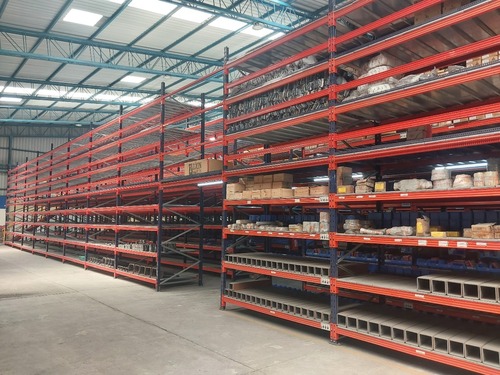
Heavy-duty warehouse shelving
Product Details:
Heavy-duty warehouse shelving Price And Quantity
- 10 Meter
- 5000 INR/Meter
Heavy-duty warehouse shelving Trade Information
- Cash in Advance (CID)
- Asia Australia Central America North America South America Eastern Europe Western Europe Middle East Africa
- All India South India Central India West India North India East India Gujarat Karnataka Kerala Lakshadweep Mizoram Meghalaya Manipur Andhra Pradesh Bihar Chandigarh Daman and Diu Goa Jharkhand Odisha Punjab Assam Delhi Dadra and Nagar Haveli Andaman and Nicobar Islands Arunachal Pradesh Chhattisgarh Haryana Himachal Pradesh Jammu and Kashmir Madhya Pradesh Maharashtra Nagaland Rajasthan Sikkim Tamil Nadu Telangana Tripura Pondicherry Uttar Pradesh Uttarakhand West Bengal
Product Description
Heavy-duty warehouse shelving is designed to handle large, bulky, and heavy items in industrial settings like warehouses, factories, and distribution centers. These shelving systems are built from durable materials such as steel, providing the strength needed to support significant weight loads, typically ranging from 500 kg to several tons per shelf. Heavy-duty shelving units are often adjustable, allowing for customization of shelf heights to accommodate items of various sizes. They are ideal for storing tools, machinery parts, palletized goods, and other large materials in an organized and efficient manner.
Common types include boltless shelving, pallet racks, and cantilever racks, each tailored to specific storage needs. Many heavy-duty shelving systems are also designed for quick and easy assembly, featuring adjustable shelves and modular designs to maximize space and flexibility in high-traffic warehouse environments. Heavy-duty warehouse shelving ensures safety and efficiency while optimizing storage capacity and reducing clutter.
FAQs on Heavy-Duty Warehouse Shelving
1. What is the weight capacity of heavy-duty warehouse shelving?
Heavy-duty warehouse shelving can typically hold between 500 kg and several tons per shelf, depending on the design, materials used, and configuration of the shelves. Always check the manufacturer™s specifications for exact weight limits.
2. What materials are used for heavy-duty shelving?
The shelves are commonly made of steel, either galvanized or powder-coated, to prevent rust and enhance durability. Shelves may also feature wooden or mesh decking depending on specific needs.
3. How adjustable are the shelves?
Most heavy-duty shelving systems feature adjustable shelves that can be moved up or down to accommodate different heights, making them versatile for a variety of storage needs.
4. What types of heavy-duty shelving are available?
Common types include:
- Boltless shelving for easy assembly and flexibility
- Pallet racks for storing palletized goods
- Cantilever racks for storing long or awkward items like pipes or timber
5. Is heavy-duty shelving easy to assemble?
Yes, many heavy-duty shelving units are designed for easy, tool-free assembly, especially boltless systems. Some larger or more complex systems may require basic tools for assembly.
6. Can heavy-duty shelving be customized?
Yes, many manufacturers offer customization options, including adjustable shelf heights, different shelf materials, and add-ons like wire mesh for increased safety or modular designs for expansion.
7. What safety precautions should be taken with heavy-duty shelving?
Ensure that the shelving is installed on a level surface, and don™t exceed the recommended weight capacity. Shelves should be securely anchored if necessary, and heavy items should be stored on lower shelves to prevent tipping.
8. Can heavy-duty shelving be used outdoors?
Yes, heavy-duty shelving made from galvanized steel or other rust-resistant materials can be used in outdoor or harsh environments, although specific weatherproofing measures may be required.
9. How does heavy-duty shelving differ from regular shelving?
Heavy-duty shelving is specifically designed to support much larger loads than regular shelving. It™s made from more durable materials and often includes design features like thicker frames and reinforced beams to handle heavy and bulky items.
10. What are the typical dimensions of heavy-duty warehouse shelving?
Dimensions vary based on the model and manufacturer, but standard shelf widths range from 3 to 8 feet, with heights up to 20 feet or more for multi-tier systems. Shelving depths typically range from 18 to 48 inches



 Send Inquiry
Send Inquiry Send SMS
Send SMS Call Me Free
Call Me Free